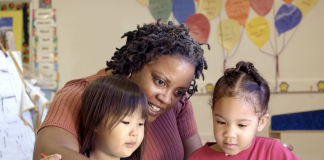Literacy/ESL
Breaking Down the Monolingual Wall V: Collaborate to Thrive
Let’s Start Here
Educator collaboration is an essential component...
California Bill Would Mandate Science of Reading
A newly introduced California Assembly bill would require the state’s teachers to be trained and reading to be taught only according to the principles...
Framing Authentic Development in Spanish
As the number of multilingual learners continues to...
Recognizing Language Disorders in Multilingual Children
Communication is a human right, in any and all languages. Children of all backgrounds start communicating from birth, though this communication looks and sounds...
Dyslexia Legislation Only Gets Us So Far
In October, education communities across the country recognized Dyslexia Awareness Month. The National Institute of Health and Yale University found approximately one in five...
No Benefit to Segregating English Learners
Grouping English learners (ELs) together in classrooms has...
Assessing Multilingual Learners’ Multiliteracies
"The notion of ‘multiliteracies’ describes the suite of essential skills students should possess in this globalized and digital age."
Significance of Multiliteracies Today’s K–12 classrooms...
Background Knowledge and Where to Get It
Stephen Krashen argues that those who read more know more
Wexler (2023) has pointed out that a reader’s background knowledge is a significant predictor...
The Promise of Automated Writing Evaluation for English Learners
Automated writing evaluation (AWE) encompasses a range of...
GAO Reports on Mitigating Learning Loss for ELs
While the pandemic presented obstacles for many students during the 2020–21 school year, the federal General Accounting Office’s (GAO’s) nationwide survey of public K–12...
I Teach Content in Secondary Schools. Do I Need to Teach...
Margarita Calderón, Leticia M. Trower, and Lisa Tartaglia...
Listen to the Bilingual Science!
Two years ago, we (Dual Language Education of...
Positioning Multilingual Learners for Success
When you were a young reader, did you connect with the books you read and...
Clarifying the Science of Reading
For at least a half-century, there has been a great deal of discussion about how children learn to read. While policymakers, curriculum developers, educational...
English Literacy for Multilingual Learners: Voices from the Field
Moving at the Speed of Light
Literacy is at...
Creating a Community of Readers
Ruben Alejandro, superintendent of an economically challenged district,...























